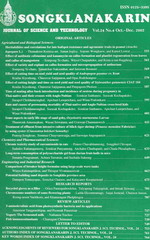ThaiScience
ThaiScience
SONGKLANAKARIN JOURNAL OF SCIENCE & TECHNOLOGY
Volume 42, No. 03, Month MAY, Year 2020, Pages 688 - 696
Optimization of the preparation treatment to obtain the desired quality of canned cowpea (vigna unguiculata, tn 5-78) variety grown in the sahel region
Moutaleb Oumarou Hama, Issoufou Amadou, Cheickna Daou, Min Zhang
Abstract Download PDF
Response surface methodology was used to optimize the preprocessing and processing parameters to obtain the best quality of canned cowpeas. The independent variables of central composite rotatable design were sodium hexametaphosphate [(NaPO3)6] concentration, soaking, blanching, and cooking time and temperature, whereas the dependent variables were hardness, moisture content, leached solid, and splitting seeds. Thus, the 5-factor, 3-level Box–Behnken design was used to establish the optimum conditions and generate regression quadratic polynomial models. The adequacy of each dependent variable were significant at P<0.05 with a regression coefficient of R2>0.90, and there was no lack of fit. The sterilization value (F0) was determined to evaluate the heat treatment efficiency under the necessary required conditions to obtain a canned cowpeas with optimum quality characteristics (i.e., soaking time of 12 h, (NaPO3)6 concentration of 0.5%, blanching time of 5 min, cooking time of 15 min, and processing temperature of 110 °C. However, the F0 value of 1.18 min obtained with canned TN 5-78 cowpeas under the optimum conditions was not sufficient enough to provide commercially stable food.
Keywords
response surface methodology, optimization, canning, cowpea, heat treatment efficiency, sterilization valueSONGKLANAKARIN JOURNAL OF SCIENCE & TECHNOLOGY
Published by : Prince of Songkla University
Contributions welcome at : http://rdo.psu.ac.th
